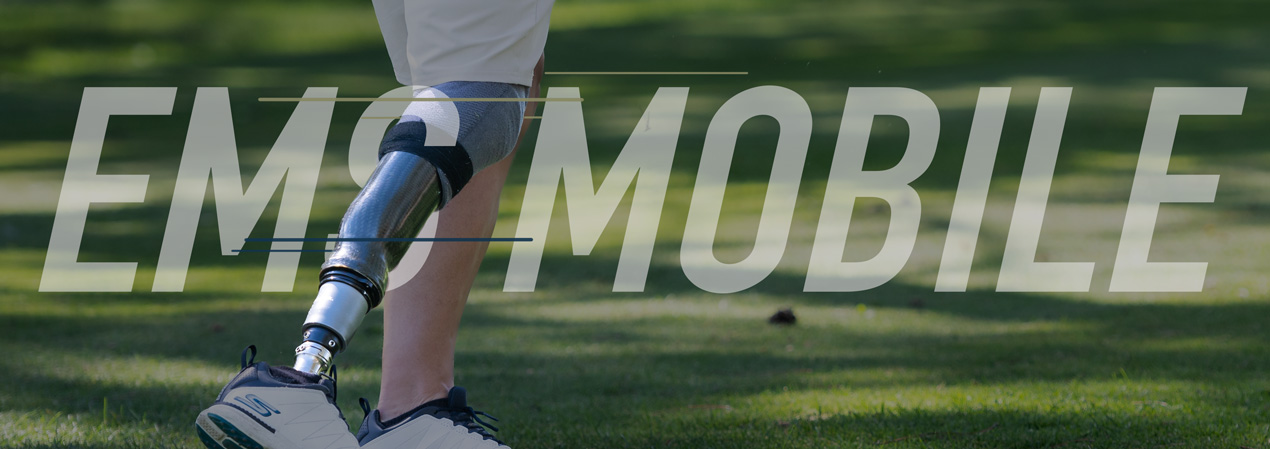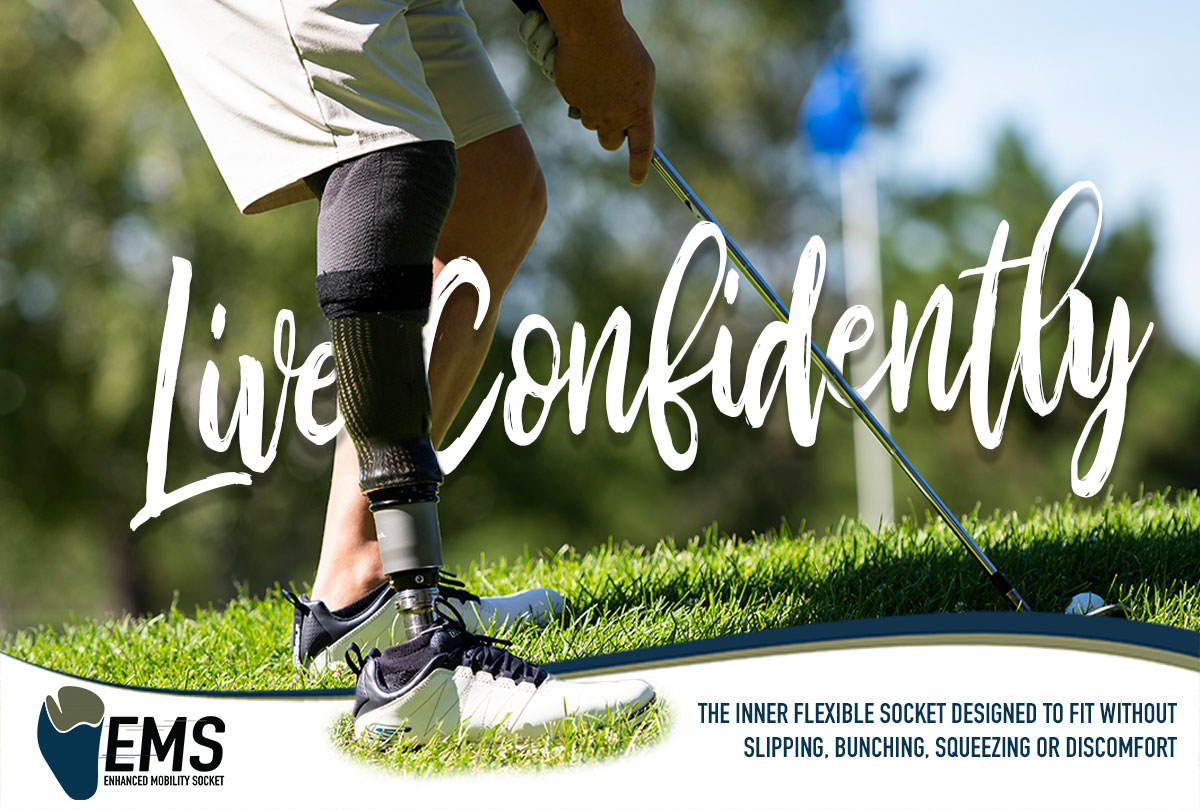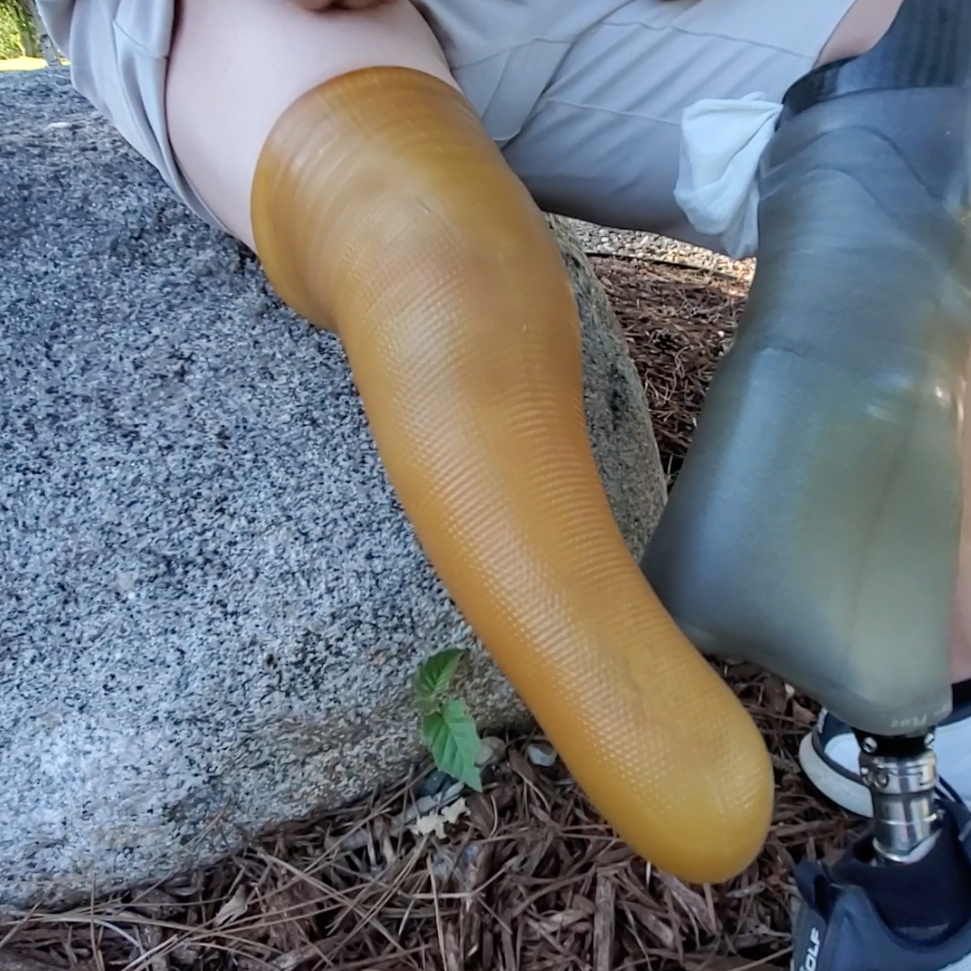

EMS: Move with Ease
Bryan Explains: EMS Locks Him In
“Better and better and better…a huge difference.” The EMS socket is soft. A typical socket is hard; you are bumping up against it every time you move. Now that my socket is malleable, it moves with me.
The EMS liner is unique. It expands under negative pressure into the dimpled socket’s surface to confidently secure it. I no longer have to walk around in my socket to settle it into place. EMS locks me in.
Case Study Findings – EMS Sockets:
EMS is Soft & Moves with the Patient
Locks You In & Stays in Place
EMS Provides a Natural Stride with a Limp-less Gait
Gait Analysis of the EMS System
EMS improves the natural gait of a transtibial amputee: Golf enthusiast Bryan Kirby explains how the Enhanced Mobility Socket System allows him proprioceptive awareness that mentally transforms his spatial movements with his prosthesis. He no longer walks with a noticeable limp, because he feels connected to his prosthetic limb as if he had toes, an ankle and a physically connected calf muscle.
Case Study Findings – EMS Sockets:
EMS Provides Spatial Awareness
EMS Provides a Natural Stride
EMS Eliminates the Prosthetic Limp
THE EMS Socket System vs. the Standard Pin System
An In-Depth Case Study: “best decision I ever made…”
“I’ve worn many different prosthetic systems over the years and this EMS socket system is by far the best I’ve ever experienced. It’s unbelievable, and it has definitely improved the quality of my life.”
Case Study Findings – EMS Sockets:
Eliminated Shrinkage
Eliminated Excessive Pain
Relieved Pressure
Eliminated Skin Wounds
Eliminated Moisture Buildup
Increased Stability
EMS Moves with the Patient
EMS Changes Lives: A Demonstration
Life Before The EMS Socket System
Video Timestamp – 00:00:44
As I said earlier, it was about 19 years ago I lost my leg, and the first eight years I was on pin system prosthetics. I’d gone to three different prosthetists during that time and each time they put me back on the pin system. During this time, I had a lot of issues with that type of system. I had pain issues, I could only walk for a certain distance before I’d had pain. I’d have to unlock the leg, lift my leg out a little bit to relieve the pressure. I could only sit with my leg bent for a short period of time before I would have so much pain that I’d, again, have to unlock it, lift the leg out of the socket, and then when I started to walk again, I’d have to lock it back in to get going. The same thing in the car, I couldn’t really leave the leg on in the car or any real length of time during a long drive, because of the pain. So, I had the issues with pain when it came to the pin system. I also had a lot of limb shrinkage. So, my limb would be a certain volume in the morning, but then because of the positive pressure of the pin system, my leg would shrink. Then I would have to add more socks to make it fit right again, and when it shrank again, it became a vicious cycle of adding more socks. But every time the limb would shrink, I’d sink in my socket. This made me walk unbalanced, which created some issues with my lower back. But overall, that was sort of a constant process throughout the day to live with the shrinkage related pain issues. Then when I took the leg off at night, the liner I had, created a lot of moisture buildup between my leg and the liner. When I removed it, the liner would just be soaking wet. And the other big issue was skin breakdowns. I had a lot of skin breakdowns, so much so, that in that eight-year period, I had to have two additional surgeries to excise wounds, because the skin broke down so much from the pin system and the tissue got bad. So, I had to have those two surgeries. There was a lot of periods where I was actually off my leg, more than I was on it, just trying to heal those wounds. When I would get a wound, I would go into the prosthetist and they would carve out the area in the socket where I was getting the wound to try to relieve pressure in that spot. The problem there however, was that would only create pressure in other areas and then I’d get new wounds in another area on my limb.
How I Heard About the EMS Socket System
Video Timestamp – 00:03:18
So anyway, I was on the pin system for eight years while having these issues, and I read an article in 2004, in the Chicago Tribune, about Ron Santo. Ron Santo was Hall of Fame baseball player with the Chicago Cubs and then an announcer for many years. Ron was a double amputee and when I had read this article I noticed he had a lot of the same issues I had with the pin system. He went to a prosthetist named Ray McKinney. Ray McKinney was, and is, an expert in elevated vacuum technology, and to make a long story short, Ray fit Ron and Ron had such great results with the elevated vacuum system that Ron Santo, Ray McKinney, and another gentleman, John McDuno opened up McKinney Prosthetics and Gurnee, Illinois. Now at that time, I was living in Illinois. So, I went to McKinney Prosthetics and I talked to Ray, kind of told him the history that I had with the with the pin system.
Life with an Elevated Vacuum System
Video Timestamp – 00:04:29
He made me a leg, it was a elevated vacuum system, it was the Harmony System equipped with the EMS Socket Technology. At that time, that is what I got, and for the first time in my life, I could actually put the leg on in the morning, leave it on all day, and not have any pain like I had in the past. It was unbelievable to be able to do that. I could walk as long as I wanted. I could sit with my leg bent for long periods of time. I could ride in the car with my leg on. I just had no issues with pain anymore. Beyond the pain, I didn’t have any more limb shrinkage. I would put the leg on in the morning, leave it on all day, and my limb would never shrink. I never had to take it off, or even have to add socks. As a matter of fact, I don’t even need to wear socks anymore. I just put on one small thin sheath.
The EMS Socket System eliminated the the issues with pain and eliminated the limb shrinkage and then the the moisture issue. I’d still have some moisture build-up between the liner and my leg, but it was greatly reduced from what I was used to with the pin system. The biggest result for me though, was that I didn’t have to deal with any more wounds. I’ve been in an elevated vacuum now for ten years, and I’ve never had to deal with any issues when it comes to skin wounds. I’ve never been forced to stay off my leg either in that ten years. I started with with the Harmony System which is a mechanical pump that creates the vacuum, and then a few years later, McKinney Prosthetics came up with an electric motor that created the elevated vacuum. The Harmony System was a mechanical pump, making it large and a little bulky, or a little heavy. Then when they transitioned to the electric motor, it was smaller with a little motor, making the prosthetic much lighter and better to walk.
Life with an EMS Equipped Elevated Vacuum System
Video Timestamp – 00:06:30
For past ten years wearing the elevated vacuum system, I didn’t think it could get any better. But McKinney Prosthetics talked me into trying this new EMS system, this EMS socket, which I’m going to show you, and demonstrate. The EMS was invented by Carl Casper’s and developed by NETTwork Manufacturing in Minnesota. *At the time of this video, there were very few prosthetist who were equipped to fit the EMS system. Prosthetists all over the United States are now using the EMS System. EMS does require a slightly different fitting technique shown in the video on our How To Order an EMS page.
But anyway, Ray McKinney, and his crew, kind of talked me into going with this EMS socket. And as I said, I was a little hesitant, because I was so happy with what I had. But I decided to try it because I trusted their judgment. It was the best decision I ever made, this system is unbelievable. *At the time of this video, EMS stood for environmentally managed system, but today, it stands for Enhanced Mobility Socket.
Donning Demonstration of the EMS Equipped Elevated Vacuum System
Video Timestamp – 00:07:55
I’m going to show it to you now. This is the EMS socket right here, as you can see, it’s very flexible, very pliable and even the the shell the socket (the definitive socket) or the shell that it goes into, is also very pliable and very flexible, as you can see as I bend that. Most sockets on the market today, anyways most sockets that I’ve had in the past, were hard. But this shell is flexible, and then of course the EMS is very flexible. It’s very easy to put on. First, you have this EMS Liner that goes on over your leg, and then you put one small thin sheath over that. Then this is the EMS socket, which is casted to your specific leg shape or the cast is made to fit. Which again, it is a little different casting technique. It’s easy, not complicated though. If the patient already has been casted, EMS can modify the measurements easily. Just call EMS and talk to our technician for easy to follow instructions. Then this small thin sock goes over that. Now your leg goes in the EMS Socket. I just stand up and do it, you can sit down. You pull the vacuum sleeve over and then there’s a small button inside here. I hit the button and now the electric motor is creating the the vacuum, which will take about 30 seconds. There, I allowed the motor to create the vacuum and I’m good to go for the rest of the day. I never have to touch it again, I leave it on all day, and just like with the other elevated vacuum I had, there’s no limb shrinkage and no skin irritations. All I do is where a couple of thin sheaths that you saw and I can leave this all day until I go to bed at night.
The EMS Socket System Has Made a Big Difference – The Results
Video Timestamp – 00:10:27
I don’t have any pain. I can walk forever. I can run. It fits like a glove. Because with the EMS equipped elevated vacuum, you’re dealing with negative pressure, also known as anti-pressure, if you will. As opposed to the pin system, which uses a positive pressure. The EMS Socket just fits like a glove. I don’t have any issues with pain, I don’t have issues with limb shrinkage, there’s no movement up and down in the socket, and the other great thing about this is when I take my leg off at night, it’s dry. It’s eliminated the moisture build-up. When I take the EMS Liner off my leg, it has no moisture build-up. The only time I’ll get a little moisture is if I’m exercising vigorously. I might get some little beads of sweat from that on my leg, but other than that, if I’m just going all day, I’ll take this leg off at night it’ll be dry. Also, there’s no skin breakdowns. Basically, all the issues I had with the pin system prosthetics are avoided with the EMS equipped elevated vacuum system, and in particular with this EMS system, the issues with pain, movement up and down in the socket, skin breakdowns, limb shrinkage, and moisture buildup are over. This EMS system eliminates those issues, at least in my experience. What has made this so good, for me, the EMS socket is what it’s given me beyond what I just mentioned.
Life’s Benefits Beyond the EMS Socket
Video Timestamp – 00:12:12
It’s also giving me added stability and range of motion. If you notice, with the EMS socket, the EMS socket comes up here (contours the knee) and grips you here (to the sides of the knee cap), whereas most sockets are going to come right around here (below the knee cap), and you don’t have that support here (along side the knee). The EMS is supporting me right here (embracing the knee). So, what I have is shaped to my knee and bends with my leg. When you bend your leg there’s no gap between my leg and the socket. In the past, before I had EMS’s elevated vacuum, if I would bend my leg, I could put a finger between my knee cap and the socket, but with EMS, it’s totally conformed to my leg. It bends with your leg.
Movement Demonstration
Video Timestamp – 00:12:48
Therefore, if I go to the gym, I can do squats and I can get all the way down. And as you notice, here once again, it’s the EMS socket that bends with your leg. It just gives you an incredible amount of stability. I can get all the way down and have total range of motion, with total stability, even with with weights, I can hold pretty heavy weights for myself.
Anyway and do squats like that and the other thing is, I mean, just to kind of demonstrate the added stability, is I can step up onto a chair or box with my prosthesis and very easily just lift myself up on this chair. It’s great for anyone, but especially for patients who are elderly who need more stability. I think this would be a great system. It’s not hard to take off and put on. Beyond the issues I mentioned you know for a fact that there’s no pain, there’s no limb shrinkage, there’s no moisture build-up, and the added stability. That’s what you’re going to get from the EMS. Oh, and range of motion. It’s going to be great for anyone, but especially elderly people who need more stability. So say someone’s on the ground, say you’ve fall’n down. It’s just so easy to get up with the EMS Socket System, as opposed to a different prosthetic system.
Looking for an EMS Location? Contact Us
Featured in this video:
SRT Prosthetics & Orthotics (formerly McKinney Prosthetics) in Gurnee, Illinois, near Chicago, and Paramount Prosthetics in Milwaukee, Wisconsin.
Amputee Regains Confidence with EMS Vacuum Socket
A Simple Case Study
Case Study Findings – EMS Sockets:
Simple To Custom Fit Patients
Eliminated Excessive Pain
Utilizes Negative Pressure
Eliminated Moisture Buildup
Increased Stability
EMS Moves with the Patient
EMS Sockets and Liners Are 100% Custom Fit
EMS Sockets and EMS Liners can be properly fitted to any limb shape. The durometer of the liner can be adjusted to the patient’s preferred specs. The durometer can range between 55 and 70, but we typically recommend starting with it at 62 or 63. If you have questions about the liner, how to cast, or any additional questions, please contact us at (855) 654-0858.

A division of NETTwork Manufacturing, Inc.
DIRECT 24/7: (855) 654-0858
40091 County Road One, Rice, MN 56367
Why Trust The EMS Socket System?
Other socket systems are rigid and non-dynamic, therefore unable to accommodate volume changes that naturally occur throughout the day. These systems use compression and pressure to hold the prosthetic in place, increasing potential for discomfort during volume changes.
The EMS System corrects this issue using increased surface area and friction coefficiency to create negative pressure and flexible load distribution, allowing the patient to comfortably maintain volume. Combined with its other features, the EMS provides amputees with a consistent and reliable connection.
With an inferior system, something as simple as sitting can be uncomfortable for an amputee. By balancing fluid changes within tissue, decreasing moisture accumulation around the skin, and accommodating for muscle movement, the EMS can provide ease, movement and freedom that other systems may not be able to.
US Patent Numbers Include: US8758449B2, US8114167B2, US20120173000A1, US20040181290A1

